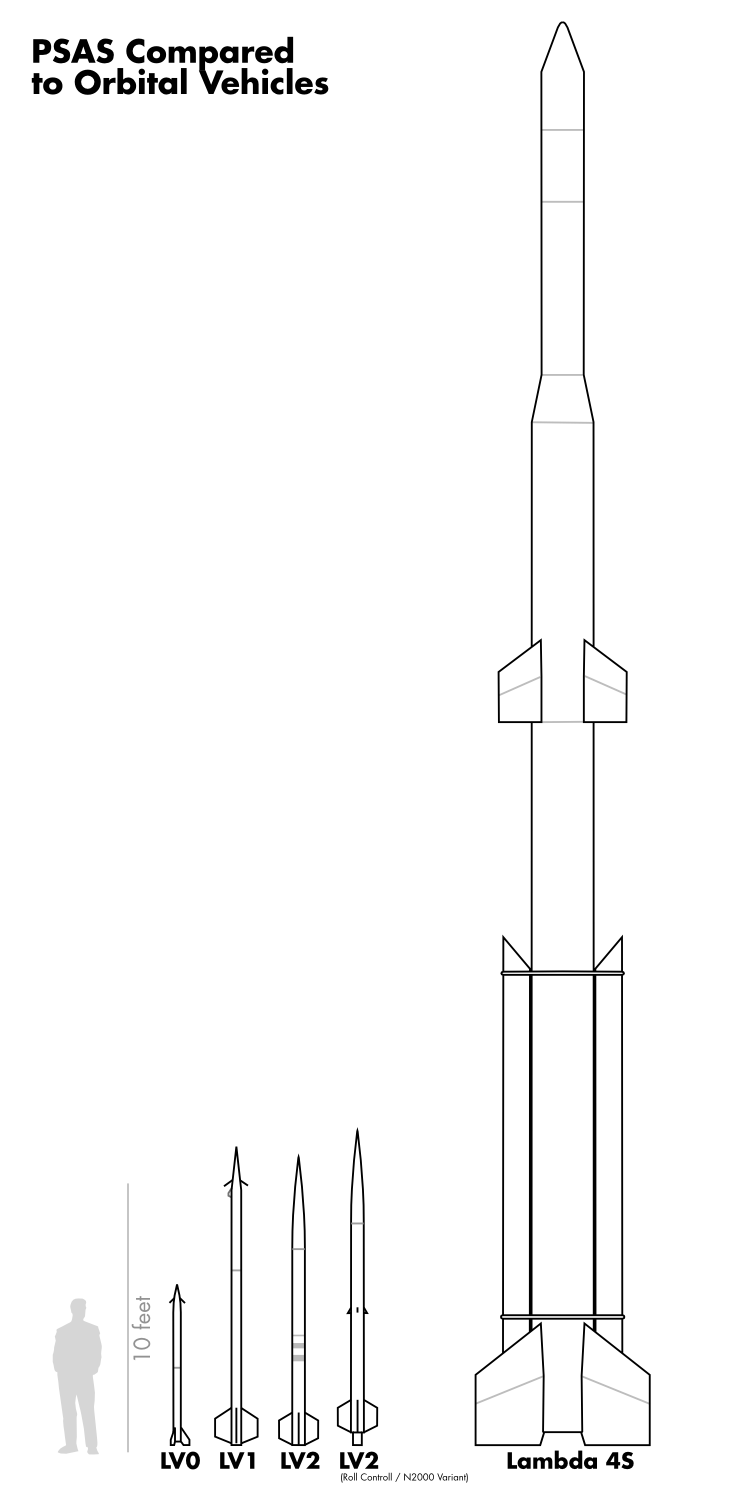Comparison of Orbital Vehicles
We're trying to figure out what the smallest vehicle that will take between 1 - 10 kg to orbit is. One way is to roughly calculate it, such as Rainier Anacker helped us to in his November 2000 lecture.
But we can also come at it the other way: what other very small orbital vehicles actually exist?
Wikipedia has a giant list of launch vehicles, of course, but they skip most of the interesting "early" tries of the 1950's - 1980's. I've tried to collect a few comparable ones here. The candidates must have successfully inserted a satellite into >= 1 orbit. There are all sorts of specs in the comparison which we've ignored here, or that may not really be comparable; this is just an overview of the different launch vehicles.[7]
| County | Org. | Vehicle Name | Stages | Propellant | M_LEO (kg) | M_launch (kg) | N_liftoff (kN) | Height (m) | Diameter (m) | Notes |
|---|---|---|---|---|---|---|---|---|---|---|
| Japan | ISAS | Lambda 4S[1] | 5 | Solid | 26 | 9,400 | 970 | 16.5 | 0.74 | 1970-02-11 took Osumi[2] satellite to LEO. |
| USA | NRL | Vanguard[9] | 3 | H202/Ker+N2A/UDMH+Solid | 9 | 10,050 | 123 | 23.0 | 1.14 | 1958-03-17 took [Vanguard 1][10] satellite to LEO. |
| India | ISRO | SLV-3[5] | 4 | Solid | 40 | 17,000 | 503 | 23.6 | 1.00 | 1980-07-18 took Rohini RS-1[6] satellite to LEO. |
| UK | RAE | Black Arrow[3] | 3 | H202/Kerosene + solid | 73 | 18,130 | 222 | 13.0 | 1.98 | 1971-10-28 took Prospero[4] satellite to LEO. |
There are a few other rockets that would fit in the "larger end" of the table: the US Scout and the French 1960's Diamant series, for example. I've left them off since they're all about the same or larger than the Black Arrow.
Note that more modern "1st orbital vehicles" are much larger and heavier since they're obviously meant to be upgraded (e.g., Brazil's VLS-1 and Iran's Safir ).
Astronautix gives a monetary amount for the "first fly-away version" of some of the rockets above, and they range in the $5 - $10 million dollar range. Whatever that means.
Summary: Rounding arbitrarily, it seems that we might be able to build a rocket that can take a < 10 kg nanosat into orbit that is < 15 m tall, < 1 m OD, and weighs < 9,000 kg.
More Details on Japan's Lambda 4S-5
Clearly the rocket of interest here is the Lambda 4S-5. It's payload capacity of 26 kg is a bit too much for us :) and the orbit is too high, but it's fairly close, and it's the lightest and by far the smallest of all the orbital vehicles. Of note is that it has totally passive guidance on all but the 4th stage (!), at which point it uses some kind of IMU.
From the ISAS site on the Lambda 4S-5 we have:
- Stage 1 (2 x 703,000 Ns + 11,890,000 Ns = 13,296,000 Ns = "X")
- Strap on boosters: 2 x SB-310 motors (5.8 m x OD 0.31 m) - 95 kN @ 7.4 s = 703,000 Ns = "T"
- 1 x L735 motor (8.40 m x OD 0.74 m) - 410 kN @ 29 s = 11,890,000 Ns = "X"
- Stage 2: 1 x L735(1/3) motor (3.90 m x OD 0.74 m) - 118 kN @ 38 s = 4,484,000 Ns = "V"
- Stage 3: 1 x L500 motor (2.50 m x OD 0.50 m) - 69 kN @ 27 s = 1,863,000 Ns = "U"
- Stage 4: 1 x L480S motor (0.50 m x OD 0.48 m) - 7.8 kN @ 32 s = 249,600 Ns = "R"
... for a total impulse of 19,892,600 Ns which is almost a "Z" motor,
They claimed a specific impulse of 215 - 254 seconds for their motors, which is about right for a solid.
More pictures of the Lambda can be found here.
Also this entry has more details (translated from Russian).
According to this the diameter was actually 1.35 m counting the strap-on boosters.
And finally, here's probably the easiest to understand of the spec pages.
As small as the lambda 4S is, we still have a long way to go to be able to build anything like it.
Indonesian RPS-420
Indonesia's space agency (LAPAN) is developing a microsat orbital launch vehicle along the same lines as the Lambda, but with the weight savings of modern materials and avionics. The design goal is to orbit a 25-50 kg microsat on a four-stage solid motor launcher, 9.5 m in length with stages 42 cm in diameter.[7] The first stage would be a three engine cluster. The RPS-420 has been in development since 2007, aiming for orbit in 2014. A suborbital version (RX-420) was first flown in July 2009, testing the proposed 1st and 2nd stage engine. Indonesia's suborbital program has already developed and flown avionics with CPU, 3-axis IMU, gyros, altimeter, thermometer, and GPS. Like Lambda, it would launch unguided at an 70º angle of inclination.
References
- [1] http://www.astronautix.com/lvs/lambda.htm
- [2] http://en.wikipedia.org/wiki/%C5%8Csumi_(satellite)
- [3] http://www.astronautix.com/lvs/blaarrow.htm
- [4] http://en.wikipedia.org/wiki/Prospero_X-3
- [5] http://www.astronautix.com/lvs/slv.htm
- [6] http://en.wikipedia.org/wiki/Rohini_(satellite)
- [7] http://en.wikipedia.org/wiki/Comparison_of_solid-fuelled_orbital_launch_systems
- [9] http://www.astronautix.com/lvs/vanguard.htm
- [10] http://en.wikipedia.org/wiki/Vanguard_1
